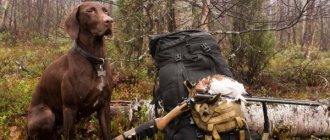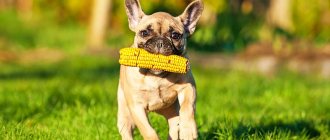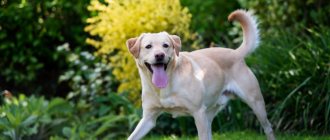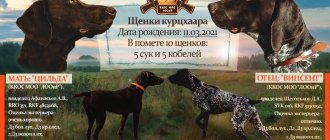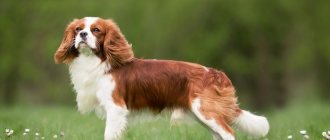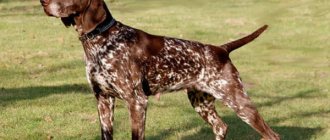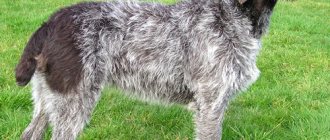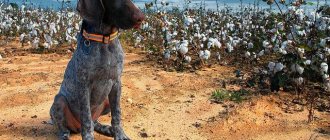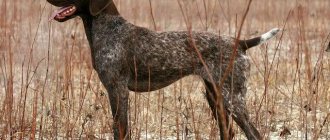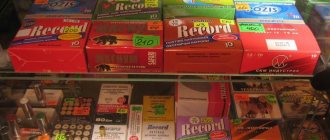Feeding the shorthaired pointer is an important component for the dog’s quality of life and has certain features. The need for a properly structured diet is the first thing you should pay attention to.
General rules for feeding animals differ from human ones. The digestive system is different, and each breed may have its own. Dogs cannot eat human food; for most dogs, already balanced dry food is more suitable.
The peculiarity of the Kurzhaar representatives is that this is a hunting breed that must receive good physical activity, and such animals require higher quality and high-calorie nutrition.
Puppies and adult dogs receive different diets and feeding frequencies, and it is also important to take into account mobility, age and body condition.
Content Features
The shorthaired pointer is a breed that can be kept both in an apartment and in a yard. The pet is smart and peaceful, but requires increased attention. In order to raise a devoted and obedient dog, you should approach training with the utmost seriousness.
In the apartment
Keeping a pet like the shorthaired pointer is a simple and easy task for the owner of an apartment. The dog has short hair, which makes it convenient to keep in a small room - cleaning will not be carried out more often than usual. The animal should be given its own corner in the apartment - this could be, for example, a warm and wind-protected place in the bedroom, living room, or a closet that is definitely not locked. The dog must be walked 2 times a day for 1–2 hours.
On the street
The dog must be kept in an enclosure suitable for its size. It must be light, clean and spacious. The room needs a booth that matches the size of the dog, a wooden floor, 2 bowls and toys. In the cold season, the pet's enclosure must be protected from snow and wind, and in the summer from the sun.
How do you cope with winter?
In winter, a dog can only be kept outside at above-zero temperatures. The shorthaired pointer can live outdoors if the temperature is not lower than +7 ºС. During the cold season, it is advisable to put hay in the booth. It needs to be replaced 2 times a week, the booth should be washed once a week.
IMPORTANT! You cannot keep a dog indoors for a long time, otherwise it will become embittered and aggressive. Kurzhaar needs freedom.
Exercise stress
The breed needs hyperactive physical activity. Games, sports, hunting - this is the only way to cope with the irrepressible energy of the shorthaired pointer. The dog will be active from childhood. She is still small for intense exercise and hunting, but she already needs games and active pastime. You can go on a short hike or jog along the alley. Your pet will be happy with everything you do together.
Exercise should be short but frequent so that the baby does not get tired. Any activity should be a joy for him. Don't make him chase a stick for an hour. Kurzhaars are smart, and even in childhood they quickly lose interest in the same type of tasks.
The important point is regularity. Train every day and gradually increase the load on your pet. Introduce new sports into your entertainment, such as agility or Frisbee.
Mating and birth
Puberty begins at 8–12 months, and complete physical development occurs by 2–3 years.
A physically healthy female dog goes into heat twice a year. But there are dogs that are empty once a year or 3 times every 2 years. The emptying period lasts about 25 days. The main symptoms of its onset are swelling of the external part of the genital organ and bleeding. On the eighth day, the discharge decreases, and the bitch allows the male.
By stroking the dog with your hand, they check whether it is ready for mating with a male; when it is ready, it turns its tail to the side.
Important! The bitch and the dog must be on leashes when mating. If a girl bites, it is best to put a muzzle on her.
Coitus lasts approximately 15–20 minutes. You can repeat the mating a second time only after 24 hours have passed after the completion of the first one.
Gestation of puppies lasts 2 months, during which time the dog owner needs to prepare for the birth of puppies. The first thing to do is prepare an area for the puppies. A box or box is suitable for this, in which you need to lay a soft bedding. Several beddings should be prepared; they will become dirty. The second is items to help with delivery: scissors to cut the umbilical cord, a heating pad and a cloth to dry the puppies.
Childbirth in dogs lasts up to 24 hours. Before giving birth, the animal begins to behave nervously - fidgeting in its place, worrying. Prenatal contractions are accompanied by the release of mucus from the vagina. The puppy appears in a bubble, the mother must chew it, if this does not happen, then the owner must intervene.
As a rule, the dog itself licks the mucus from the puppy, but during the first birth it may become confused. Veterinarians advise stretching the bitch's nipples before giving birth - this will make it easier for newborns to suck on the breast. After giving birth, the animal needs to replace the bedding and attach the puppies to the chest.
Diseases
The most common diseases of shorthaired pointers are:
- bloating;
- otitis externa;
- cataract;
- melanoma;
- entropy;
- hip dysplasia and hot spots (eczema).
Advice! If you notice that the animal has become lethargic, has not eaten for 24 hours, is feeling sick or vomiting, then this is a signal to urgently contact a veterinarian.
Upbringing
Dogs need to be trained from an early age. First you need to accustom the animal to its place of sleeping and feeding. You should teach the puppy not to be afraid of personal hygiene procedures - combing the fur, trimming the claws, cleaning the teeth, ears and eyes. The pet does not need frequent bathing - once a month is enough. In the summer, dogs love to swim in ponds. Puppies in an apartment should be taught to relieve themselves in straw, sand or newspaper.
IMPORTANT! Under no circumstances should a dog be taught to relieve itself on rags or any material, otherwise the puppies will “go” on the carpet, clothes, etc.
Puppies must be taught from an early age to interact with other animals. This breed of dog does not like to be alone, so leaving it in an apartment for a long time is not recommended.
The main thing is to determine the character of the pet and build on this in terms of education. During training, you should not be irritated, hit or shout at the dog. If an animal grows up in a nervous environment, it may become an aggressive animal. The shorthaired pointer is a breed of energetic dog, so you need to walk them a lot and spend personal time with them.
Character
Shorthaired pointers are born hunters. But they remain gentle, friendly pets. Character traits such as curiosity and irrepressible energy stand out. Therefore, kurtshaars require a lot of time and attention. It is necessary to study and play with them, otherwise he will direct his energy to destroying the apartment.
Hunting dogs are pets of “one owner.” But he will also love and protect the rest of the family members. Children are treated very well. The Shorthaired Pointer will make a nanny who will never allow the child to be offended either by herself or others.
Representatives of the breed have high intelligence, so they tend to be self-willed. But they also like to please their owner. They get along well with other animals if they grow up with them. But these dogs will still perceive small animals as prey - instincts take over.
What to feed an adult dog?
The shorthaired pointer is a fairly large hunting breed with strength and endurance. The pet can be fed natural food or dry food. If you feed your pet dry food, then you need to choose granules for energetic and active dogs that are appropriate for the pet’s age.
High-quality dry food contains vitamins and microelements that are important for the dog’s body, so there is no need for additional supplements.
If the animal is fed natural food, then the owner needs to know that 50% of the diet is chicken, beef, pork and offal.
Important! Smoked meats in the form of sausages and frankfurters are harmful to dogs - they negatively affect liver function.
The menu should include vegetables, both raw and boiled. Potatoes, radishes, pasta, sweets and peas are harmful to dogs. Fish, eggs and dairy products can only be given once a week.
Your dog should not be given food from the refrigerator or directly from the stove. The food should be warm; in addition, you need to provide a bowl of water. During the cold season, a pet living on the street should increase its diet. In cold weather, it is advisable to feed the animal food rich in calories. Oil can be added to food and supplemented with vitamins A, B and E.
IMPORTANT! For a dog living in an apartment, the menu does not change.
Brit Care lamb with rice 12 kg (for large breeds)
The food is produced in the Czech Republic. It is rich in protein due to the significant amount of natural meat and fish in the recipe. Rice is used, enriching the body with carbohydrates, including fish and chicken oil, which produce fatty acids. Brit Care is most useful for large breeds, because its components prevent joint diseases - a problem for many large four-legged pets. Premium and super - premium class.
pros
- Vitamins and minerals in balance.
- Hypoallergenic.
- Nice smell.
- Causes a huge appetite.
- Optimal size granules.
- High quality.
- For a healthy pet's body.
Minuses
- It smells strong.
- Unpleasant color.
- Too dry.
- Not suitable for all breeds.
- Insufficient bag volume - up to 12 kilograms.
Choosing a puppy
The main rule when purchasing is to make it from a professional breeder or a reputable nursery. There you can evaluate the appearance and behavior of the litter of its parents. If a bitch and a dog have no deviations either physically or psychologically, then their offspring will also be strong and healthy.
Neither parents nor puppies should show any signs of cowardice or aggression. If dogs are sociable, they themselves come into contact with people and other animals with curiosity, then there are no vices in their character.
Publication from Hunting and Fishing (@hunting_and_fishing_in_russia) Jun 13, 2022 at 10:17 PDT
The average price of breeding class puppies is 30-40 thousand rubles. These dogs come with all the necessary certificates and a passport. Professional breeders will answer questions and help you choose a suitable shorthaired pointer puppy. If you need a top-class show dog, then prepare an amount of around 60 thousand rubles. Future champions will have titled parents and maximum compliance with the standard in all respects.
The Internet is replete with advertisements for the sale of shorthaired pointer puppies for 2500-3000 thousand rubles. Such “Germans” are mestizos and are obtained from unscheduled matings, which means that no one can vouch for their mental balance and physical health.
Acana Puppy Large Breed, 11.4 kg
Acana Puppy appeals to every furry friend and turns into a favorite bowl. Transforms the animal's fur into smooth and silky, bones will be stronger, and more energy will appear. Thanks to these crackers, your beloved friend is provided with a balanced diet. Many breeders of our smaller four-legged brothers recommend them to everyone else. This is a holistic class.
pros
- Natural.
- Without smell.
- Large packaging.
Minuses
- High price.
- There is a fishy smell.
Baby care
Before you bring a puppy into your home, you need to arrange its future home. Buy or make a bed out of an old box and blanket. Dogs of this breed do not tolerate dampness and drafts well. The sleeping place must be placed where it is dry and warm at any time of the year.
Take care of drinking and water bowls, toys, walking accessories and fur brushes. Buy hygiene products at the veterinary pharmacy. The breed is considered unpretentious, but basic care procedures will have to be performed. Moreover, the shorthaired pointer is accustomed to them “from a young age.”
Posted by Mickey (@mickeyaww) Jul 5, 2022 at 11:46 am PDT
These are smooth-haired dogs, but they shed a lot. The process is year-round, so you will have to comb it every day, starting from the moment the dog appears in the house.
The ears should be inspected weekly and wiped with a damp cloth. To treat the eyes, use a weak tea brew - do this once a week.
Claws are trimmed as they grow. Frequent bathing is not advisable for the shorthaired pointer - once every one or two weeks will be enough. It is very important to carry out timely treatment against parasites and worms.
Owner reviews
Galina.
Hello! This is our first dog. Sherlise. We adopted her when she was 3 months old. Now she is 9 months old. There were no special problems while keeping her. Very easy to train. Not picky about food. Easy to care for, there is practically no smell from the skin. Smart. Gets along well with children. Very very patient. If the child is very small, then at first it is better to monitor the communication between the dog and the child. To build the correct behavior of the dog Stop aggression. The child is 2.8, so he crawls on her, walks, pulls everything he can, but she doesn’t do anything... Even though we keep an eye on him, he still manages to torment her. Because of the size of an adult puppy, games of catch are better cancel. May drop the child :) There are some nuances. There may be minor problems with toilet training. If the parents are kept in an enclosure, then puppies from such parents are difficult to learn to be patient. But in an apartment this is important. Therefore, you will have to walk such a dog more often. Approximately every 2-2.5 hours. From 4 months onwards, the time can be increased. Another drawback of shorthaired pointers is that they like to pick up all kinds of crap on the street. This must be monitored and immediately weaned off. They will not stop picking up at all, so we teach the command “drop” " The dogs are very active. They need to be walked for at least 3 hours a day. They love to run, jump, and play. Therefore, it will be good if there is somewhere to run. They are very sociable with other dogs. Because of their love for everyone, they are not suitable as a watchdog. Can frighten unless we bark. The voice is very loud :) but they rarely bark. I recommend it as a friend and a hunter. They are excellent hunters. Each one baits differently. We only went hunting 4 times. He studies well, but for now he mostly talks and plays. I wish everyone good luck in raising your pets!
FRider
I've never had a dog before! My wife and daughter decided to convince me that having a dog would be funny, fun, interesting) Considering that my wife used to have a dog of the Shorthaired Pointer breed, she loved it very much and the decision was made to get this particular breed. Then I had no idea that the dog would be completely on me...
We found an advertisement for the sale of puppies and arranged a meeting with the breeder. The puppy was brought to us from another city. When I took it in my hands, he immediately began to lick me. It was touching, but then I had no idea what would happen next.
On the first day, I left for work, and my wife and daughter stayed to babysit him. Towards evening, I receive this message from my wife: “Let’s get him back.” The puppy was not yet accustomed to the new home and was whining every 5-10 minutes. Seriously! This lasted for several days. Of course I said no. We will not return!
The puppy grew, but still often went to the toilet in the apartment. Of course, this had a negative impact on our psyche.
One day, when we were not at home, he snuck into the child’s room and chewed up a lot of toys. The damage was severe, both financially and mentally. My daughter “lost” her favorite doll.
It is difficult to describe what we experienced then.
Time passed, I decided to raise a very active puppy. We signed up for OKD courses and started taking them to exhibitions.
Now he is already 3 years old and sometimes he can still go to the toilet at home, but this is very rare.
Then we made the mistake of taking a puppy. And not because he was crap or a hooligan, but because dogs of this breed should live with a hunter. But in our family there are no such people.
No matter how sad this story may sound. We still love our dog, we pet him (in a good way) and play.
By the way, a lot of fur flies off of it) You need to vacuum it every day!
Mentally
In April, at the age of 11, our beloved and devoted friend, a shorthaired pointer named Kora (emphasis on O), left us. But let’s not talk about sad things, I’ll go straight to the description of the breed and character of our favorite.
Reading reviews from owners on this site, I got the feeling that we were talking about different dogs. Why is that? Let me start with the fact that ours had a very difficult character, I would say complex. In childhood, when I was a puppy and until about 3 years old, when I was left alone in the apartment, I constantly spoiled and chewed things (it’s no joke, throwing out 18 pairs of shoes, we remembered this number for the rest of our lives). The dog was raised and punished, but apparently this was how she expressed her dissatisfaction with loneliness, and over time she outgrew it.
It is worth noting that the dog established a clear hierarchy for itself in the family and adhered to it until the end of its life. The most important people she obeyed unquestioningly were her grandfather and grandmother; Mom and Dad were at her level, she obeyed, but could show her teeth and growl when she was punished. I, since I myself was a child of 9 years old when Cora came to us, I think, was in the role of a younger sister, whom she did not value at all). She started listening to me when I was 18 years old.
Our shorthaired pointer was also completely unresponsive to strangers in the house or on our summer cottage. The intercom rang, the door rang, someone walked past the fence at the dacha - the dog immediately started barking, showing how she was defending the territory. If a stranger was in the house, the dog could bark (but never rush or bite), and always watched him, what he was doing and where he was going. So, for example, Cora spent more than 3 years getting used to my boyfriend, although he was at home almost every day. And only a year and a half before her death, she began to approach him to stroke him, stand with her front paws on his shoulders and show her affection in other ways.
So ours had very clearly expressed security skills, and not hunting ones.
They never took him hunting because the dog was very afraid of thunderstorms, thunder, loud shots and bangs. At the age of 10, during a thunderstorm, she even had a seizure, when she fell to the floor and began to thrash in a fit.
At the same time, the shorthaired pointer is a very loyal dog, as others have written. She really didn’t like it when the family left and she was given to her grandfather at home; she could refuse food. When we came home, even if we were away for less than 10 minutes, the dog was happy as if many hours had passed.
Still, I think that the features that I described were simply characteristic of her due to her individual character. Every dog is different, even if the breed is the same.
Love your pets, health to both you and them!
Catdog Sima
A very harmful dog is very good at learning bad habits. They pee at home. They bark loudly and eat a lot. The nasty face of a choleric person. They gnaw on things regardless of age and condition. Literally chewing up cats. They can easily tear apart chicken, goose, hamster, parrot and small rodents. They demand a lot from the owner. They are not particularly effective when hunting. You have to walk with them for a very long time and they will still spoil the house. They rush at people. They tear up furniture, wallpaper and flooring if they live at home. If they live on the street or in an enclosure, they bark very loudly. My dad had a lot of shorthaired dogs and they were all the same nonimal and the dog handler still behaved like that.
Anonymous858938
My shorthaired pointer was with me for almost three years, and as a result, as an owner, he obeyed me unquestioningly, but completely ignored his youngest son, 8 years old. Dog from the Kurzhaar club in St. Petersburg. Once he showed aggression towards an 8 year old child. The result is a 3-hour operation and 35 stitches on the scalp (lucky that the face remained intact). Put him to sleep the same day. I think that it is suitable for kennel keeping outside the city and for use exclusively for hunting; this dog is dangerous for a family.
Video
Feeding
In the first month of life, the shorthaired pointer's diet consists of one ingredient - mother's milk. Gradually, cottage cheese, yogurt, and kefir are added to feeding. Starting from three months, milk is given less and less - the main emphasis is on solid foods. They help replace the young “hunter’s” teeth.
During this period, puppies must be fed cartilage and offal, but it is better to wait with minced meat. It can cause indigestion.
Dishes made from any cereal (except pearl barley) cooked in meat broth will be healthy. Salt and potatoes should be avoided.
Gradually, the shorthaired pointer's menu should become more diverse. The presence of fiber is required. There is a lot of it in zucchini, pumpkin, and cabbage. For the first five months, the shorthaired pointer puppy is fed five times a day. From six months this number is reduced to three. Starting from 12 months, the “teenager” is transferred to an adult diet - twice a day.
Sweet, spicy, smoked or fried foods are unacceptable for the puppy. It is also necessary to exclude flour products and tubular bones. Instead of “natural” food, you can give ready-made food for large breed puppies, but only premium class or higher.
Vaccinations
During the first two months of life, dogs have maternal immunity, so no injections are given during this time. Up to a year, shorthaired pointer puppies are vaccinated three times. The first vaccinations are given at 2.5 months. The injections are given in fractions - twice with a weekly interval. Then after changing teeth (six to eight months). The last time is when the pet turns one year old. Then he is considered an adult, and they have their own schedule.
All dogs, regardless of breed, must be vaccinated against:
- parvovirus and coronavirus enteritis;
- hepatitis A;
- plague;
- leptospirosis;
- rabies.
Deworming is carried out two weeks before injections. During this entire time, the dog must be absolutely healthy. If even the slightest symptom of poor health is observed - loss of appetite or fever - the vaccine cannot be administered. After vaccination, quarantine is required. It is necessary to avoid swimming, drafts and overwork.
Raising a shorthaired pointer puppy and its training are closely related. Command training is built on the basis of friendship between a dog and a person. Without proper upbringing, it is impossible to acquire a devoted friend.
The first thing to do is to accustom the baby to his bed and bowl. He must learn where his place is. No matter how cute and defenseless he may seem, do not allow the puppy to climb onto the table or bed, even if he begs and whines.
Teach him to calmly endure hygiene procedures. While trimming nails or examining ears, constantly praise and treat him with a treat. Then he will begin to associate procedures with something good.
Straw, newspaper or sand are used as a toilet for the little friend. Do not train him to “walk” on rags, otherwise in the future the dog will perceive carpets and clothes as a place to relieve himself.
Early socialization is important for Shorthaired Pointers. From childhood, accustom them to other animals and people. Then you will have a sociable and friendly dog.
Training
There is no consensus among dog breeders about when command training should begin. Some believe that not earlier than six months. Others insist that 3 months of shorthaired pointer training is the best time to learn simple commands at home. At this age, the puppy can be taught to sit, lie down, stand, give a voice and fetch a stick (“Fetch”). But everyone agrees that the main command that the baby must learn is “Nearby.” It is indispensable during walks.
Closer to six months, training a shorthaired pointer puppy includes working on hunting commands. There are even special huntsmen-trainers who help hone the instincts of cops.
During training, the owner should not allow himself even a hint of irritation. There is no question of assault. One hit is all it takes and you will disappoint your pet forever. You can't raise your voice. The speech is commanding, but calm. Attempts by the Shorthaired Pointer to dominate must be immediately stopped.
For each correctly performed exercise, the pet must be praised, petted and treated with a treat. Training is like a game, not like a military drill.
Keeping shorthaired pointer dogs in an apartment
Having decided to give the German pointer his own corner in the house, the owners do not have to worry about intense shedding and hair on furniture and clothes, since this animal has short, smooth hair. Of course, periods of shedding are inevitable, but the amount of short, coarse hair on this dog will be minimal.
The pet must know its place in the family and understand that the owner is a kind of “leader” in the house, whose commands he must carry out.
From an early age, German Pointer puppies are taught to follow certain rules: sleep and eat in a strictly designated place, do not jump on furniture, and react calmly to other animals in the house and guests. It is important to form the correct routine for your dog, which must include time for walks, games, training, and performing new tasks.
Representatives of the breed are not recommended to be kept locked up for a long time and left alone. This will lead to the pet’s embitterment, excessive aggression, cowardice and a violent outburst of energy in the house, which can result in damage to furniture, walls, and things.
Keeping a shorthaired pointer in an apartment is a more painstaking and time-consuming task than living a dog of this breed on the street, so if the future owner does not have the opportunity to provide the pet with all the necessary conditions, it is better not to purchase a German pointer.
Despite the fact that the German pointer is a hardy, unpretentious animal that has been used for hunting in the field for several hundred years, if you keep it at home you will have to take proper care of it.
Caring for a shorthaired pointer will require effort and financial investment, as with any large breed. The dog is taught hygiene procedures from an early age. Even as a puppy, the pet must endure all procedures steadfastly, not be nervous or worry during them, considering them a habitual ritual.
First of all, care will consist of cleaning the coat and keeping it in good condition. The German Pointer does not need frequent bathing; it is enough to wash it only when its fur is very dirty. The rest of the time, hygiene procedures come down to washing paws after walks, cleaning ears and eyes. In summer, the dog can be washed more often; home bathing in the warm season will replace swimming in open water, which will bring great pleasure to the shorthaired pointer.
Care also includes trimming the nails (once a month), weekly combing of the coat with a special brush, a proper diet, daily walks with physical activity, and timely vaccination.
Shorthaired Pointer vaccinations are given when the puppy reaches two months of age. The first vaccinations are needed to protect against distemper, hepatitis, enteritis, and rabies. Vaccination helps develop immunity in the animal to serious canine diseases. However, one vaccination is not enough for this; it is necessary to administer a set of vaccinations throughout the year, observing intervals. So, from 4 to 5 months the puppy’s teeth change, so you should refrain from vaccination. You cannot vaccinate a weakened, unwell, and especially sick dog.
Story
The pride of German dog breeders. Among the three hunting ones, he is recognized as the best. His descendants are the Württemberg Pointer and the Pointer.
The Germans carefully approached the breeding of these dogs. Attention was paid to physical qualities and the ability to bring prey and accurately carry out commands. In translation it means kurts - short, haar - hair. There are also other names for this breed - pointing dog, shorthaired pointer. They used dogs for hunting in those days when there were no firearms. The ability to sneak up on prey unnoticed was highly valued.
When they began to use it, the problem of finding game arose. When killing birds from a great distance, we had to get them from inaccessible places. Kurzhaar bravely threw himself into the cold water to catch game. In the 17th century, partridges were introduced from Spain. Together with the bird, an excellent hunter for them was brought to the lands of Germany - the dog Perdiguero de Burgos. These breeds were crossed.
The result exceeded all expectations. The animal became much stronger, without losing its agility, and was named the Old German Württemberg Pointer. A shorthaired pointer breeding club was created, a standard was written, and amendments were made. Improvement continues to this day.
Breeders are working to reduce the number of congenital diseases and preserve the dog’s working qualities. At the beginning of the 20th century, dogs came to the United States, where they were appreciated. The American shorthaired pointer is loved by hunters. Clubs for its breeding have been created. Short-haired cops came to Russia gradually. In the harsh conditions of the north, the husky was more often used.
- Cat claw attachments
- Dog
- Long-eared cats
- Cat meowing
- Alexandrian parrot
- Why does a cat need a mustache?
Keeping a shorthaired pointer in an outdoor enclosure
When keeping a shorthaired pointer in an enclosure, its owner will have to comply with some requirements: the pet’s place of residence must be bright, clean, dry, spacious and protected from drafts. Fresh drinking water and toys should be kept in the enclosure.
The enclosure for a German pointer should be 2/3 m in size. Its base is best made of metal, and the floor, wall and ceiling are made of wood. It is imperative to provide a strong latch so that a strong dog cannot get out. You will need to install a booth in the enclosure, which will serve for the animal’s comfortable sleep and rest.
When keeping a shorthaired pointer on the street, it is not recommended to keep the dog on a chain, since in this way it will never be possible to raise a loyal, kind friend. The chain will always cause a desire to get rid of it, anger, irritate, depress the pet, and even cause negative emotions towards the owner who has prepared such a fate for him. There have been cases when the chain caused injury to the animal. Having built an enclosure, the owner of a German pointer will solve several issues at once: provide the dog with relative freedom, create reliable protection from the cold, and get an excellent guard. The only caveat is that you can build an enclosure only if you live in a private house and have your own plot. If the owner of this breed lives in an apartment, he will have to keep the pet at home.
If it is impossible to build an enclosure or there is not enough space for it, you will have to install a doghouse for the dog, but only if the owners live in a region with a warm climate. The booth must be spacious enough to accommodate the large size of the animal. It is better to choose a place at higher elevations, this will help avoid excessive humidity. The shorthaired pointer's home needs to be insulated, hay laid on the bottom, and a blanket or soft rug placed on top. Keep the kennel clean, regularly clean the inside, and also clean the area where the dog lives.
Almo Nature Holistic beef 12 kg (for large breeds)
Italian crackers of excellent quality with meat additives do not violate European standards. They have the aroma of real meat, causing an excellent appetite in your beloved pet. They contain protein, but in minimal quantities. The animal receives adequate nutrition by consuming it regularly. Almo Nature belongs to the super premium category.
pros
- Dogs love its taste.
- Hypoallergenic.
- Wide range of tastes.
- Fresh natural ingredients.
- There are no artificial additives, dyes, preservatives, or flavors.
Minuses
- Sometimes causes hair loss.
- The pet may refuse to eat it.
Care and feeding of a shorthaired pointer puppy
When caring for a shorthaired pointer puppy, the owner must perform every action with the utmost caution so as not to cause pain or discomfort to the animal, thereby not causing rejection of a particular procedure.
Regular care of the shorthaired pointer and proper maintenance from an early age will help raise a strong, hardy, energetic and cheerful pet.
Feeding a shorthaired pointer puppy and an adult has its own characteristics and differences. In the first month of life, the puppy should eat its mother's milk. In the absence of such an opportunity, the owner takes care of feeding the baby, using formula with cow or goat milk for the first months, gradually including dairy products such as cottage cheese, kefir, fermented baked milk, and yogurt in the diet. From 3 months, the amount of milk is reduced, solid foods are introduced into the diet: offal and cartilage, which are necessary when changing teeth. It is too early to give minced meat during this period, since the puppy is not yet able to chew it thoroughly, which means it will not be digested well.
It is useful to give porridge from any cereal cooked in meat broth from the 3rd month of life. Barley and potatoes should be avoided. Salt is also not needed when preparing dog dishes.
There are many options for what to feed a shorthaired pointer puppy, the main thing is to make the menu varied and balanced, containing proteins, fats, carbohydrates, vitamins, minerals, and fiber. Fiber is found in various vegetables: zucchini, cabbage, pumpkin and others.
For the first 5 months, feeding a shorthaired pointer puppy should be done 5 times a day, starting from the age of six months, its number is reduced to three. Upon reaching 12 months, the grown and strengthened pet is transferred to two meals a day.
When preparing a diet for a puppy, you need to completely exclude sweets, flour products, spicy, fried and smoked foods, as well as tubular bones.
CHAPPI MEAT ABUNDANCE WITH VEGETABLES AND HERBS, adults
https://dog-care.ru/zdorove/pitanie/luchshih-suhih-kormov-dlya-kurtshaara.html
CHAPPI is produced in Russia for economy class. It contains cereals, which are considered the best sources of carbohydrates. Proteins are present in the form of meat and offal. Use vegetables, for example, carrots, vegetable oils. CHAPPI is convenient because there is no need to add vitamins to it; they are already contained in sufficient quantities.
pros
- Wide availability.
- Nutritious food.
- Does not cause constipation in the animal.
- Decent quality.
- Promotes healthy appearance of coat and teeth.
- Doggies like it.
- There are no artificial flavors or flavor enhancers.
Minuses
- Treatment of the animal after eating these dry granules.
- Bad composition.
- Allergic reactions.
- Hair falls out.
- Bloating.
- Not suitable for all individuals.
- Unattractive packaging.
Nutrition of an adult shorthaired pointer
The German pointer is a hunting breed with large size, strength and endurance, therefore the diet of this dog must be taken responsibly. The diet of an adult shorthaired pointer can consist of both natural food and dry food. Having settled on granules, you should give preference to those foods that are intended for active, energetic dogs. In addition, dry food must be appropriate for the age of the animal.
The advantage of ready-made food is that you don’t have to prepare the food; you just need to pour the required amount of granules into a bowl. It is also important that high-quality food provides the dog with all the necessary microelements and vitamins, so additional supplements are not required.
What to feed a shorthaired pointer if the owner decides to stick to natural food? First of all, it is important to consider that every day 50% of the diet should consist of meat - cooked or raw. Chicken, beef, pork, rabbit and offal are suitable. However, sausage, frankfurters and various smoked meats are harmful products that negatively affect the animal’s liver.
Every day you need to include fresh and boiled vegetables in your four-legged friend’s daily menu. It is better to exclude radishes, potatoes, pasta, peas, and sweets from the diet. Once a week, the pet should receive sea or river fish, fish oil, eggs, and dairy products. To improve the functioning of the intestinal tract, you should give porridge.
There should be a container of clean drinking water next to the food cup. Regardless of age, you should not give your dog cold or hot food; it should be warm or at room temperature.
With the onset of cold weather, the diet of a Shorthaired Pointer living outside will change, as the animal will spend more energy to generate heat. Now the dog will need more high-calorie food with the addition of vegetable or butter. In the cold season, you can feed boiled udder, offal, beef tripe and add liquid vitamins A, B and E to the food.
When using dry food, in autumn and winter, increase its quantity from 500 – 600 g to 800 g.
For a dog living in an apartment, the diet will not change in the autumn-winter period.
Purina Pro Plan Optiderma for Healthy Skin and Coat, Salmon with Rice, 14 kg (Large Breeds)
A healthy body and the well-being of an animal are the result of its optimal nutrition. Purina Pro Plan was developed by Russian veterinarians and nutritionists. The composition includes specially selected nutritional components for four-legged pets of different sizes, weights and ages. It suits even special preferences and keeps the animal in excellent condition. Belongs to the premium class.
pros
- Decent composition.
- Wide range for any age, size.
- Nutritious with all the vitamin complex.
Minuses
- Flavoring additive.
- Doesn't cause much appetite.
- Not available everywhere.
- Creates increased gas formation.
How to properly feed a shorthaired pointer dog
Feeding the shorthaired pointer is an important component for the dog’s quality of life and has certain features. The need for a properly structured diet is the first thing you should pay attention to.
General rules for feeding animals differ from human ones. The digestive system is different, and each breed may have its own. Dogs cannot eat human food; for most dogs, already balanced dry food is more suitable.
The peculiarity of the Kurzhaar representatives is that this is a hunting breed that must receive good physical activity, and such animals require higher quality and high-calorie nutrition.
Puppies and adult dogs receive different diets and feeding frequencies, and it is also important to take into account mobility, age and body condition.
The shorthaired pointer is an active breed, what to feed them is determined by the owner, food can be:
- Natural;
- Ready-made feed (dry);
It is recommended to feed an adult shorthaired pointer 2 times a day, morning and evening. At the same time, ensure constant access to drinking water. A premium food that is already balanced and contains all the necessary nutrients is ideal. Ease of use and balance are its main advantage.
Suitable for natural feeding
- Lean meat - veal, beef, chicken, turkey;
- Specialized meat kits that can be ordered from representatives of nurseries or breeders;
- Sea fish without head and bones;
- Vegetables (carrots, zucchini, beets, pumpkin, cabbage and cucumbers);
- The diet should include: kefir, fermented baked milk, low-fat cottage cheese, eggs.
Calculating the daily requirement is still difficult, it comes from the initial weight of the dog and is equal to: 3% of the total weight of the animal. Take into account: physical activity and age. Once a week the dog should receive fish instead of meat, the volume of fish should be 2 times larger.
Calculation of natural food 30 grams of meat per kilogram of animal - for adults, food based on 100% of the total 30 - 40% porridge or vegetables, it turns out about 300 grams - vegetables. An animal weighing 35 kg should receive 1.2 kg of food per day.
- All vegetables are given only raw, minced or finely chopped. You need to add a tablespoon of oil to vegetables.
- From cereals you can give: buckwheat, wheat, oatmeal, rice, alternate.
- Do not overfeed your pet, otherwise the digestive system may become disrupted. A complex of minerals is connected to the natural product.
- Give once a week: apples, zucchini, pear. Avoid citrus fruits.
It is forbidden to give
- Leftover food from the table;
- Tubular bones;
- Chicken bones;
- Flour and bread;
- Baking;
- Fat meat;
- Pork innards;
- Sugar, cookies;
- Chocolate;
- Salty, spicy, peppery;
- Fried.
Important. Your pet should receive either natural food or dry food. It is prohibited to alternate them.
Sometimes dogs become allergic to certain foods; they must be immediately excluded from the diet. Manifestations can be on the skin (in the abdomen), between the fingers, red ears - which the dog will scratch.
Be sure to give solid food that helps clean plaque from the teeth: special bones - treats, deer antler, which can be chewed for a long time, usually sold at exhibitions. In veterinary stores you can buy tendons, which also contribute to the process.
OUR DIET WITH BEEF, 15 kg
OUR DIET, produced in Russia, provides the body of four-legged pets with the entire complex of nutrients, vitamins, and minerals that are so necessary for health. The composition contains natural ingredients, probiotics that support the immune system. The dog is healthy and active all day long thanks to fatty acids, chicken and salmon fat. The listed components are present in the specified diet. Considered economy class.
pros
- Qualitative.
- The dog eats with pleasure.
- Gives activity to the animal.
- The fur shines and shines.
- Well absorbed.
- Choice of flavors.
Minuses
- Large granules.
- Cats eat.
- Only for large representatives of the breed.
Pros and cons of natural and dry food
Pros:
- Balance;
- Ease of readiness;
- Ideally selected composition;
- Does not require additional preparation;
- Has all microelements and vitamins;
Cons: premium food, quite expensive.
Pros of natural:
- Quality products;
- More varied diet;
Minuses:
- Lots of time to prepare;
- Difficulty in calculating diet;
- Possibility of ingestion of low-quality products;
- Due to incorrect calculation, there is a possibility that the pet will not be able to receive sufficiently high-quality food.
The Kurzhaar (German: Kurzhaar, from kurz “short” and Haar “hair”), or German Pointer, is a German short-haired pointer. Bred in Germany. The basis for the creation of the breed was the old German shorthaired pointers. A very active dog. The closest relatives of the shorthaired pointer are the drathaar and langhaar. History of the Breed The history of the German Shorthaired Pointer begins with dogs that were used for bird hunting with nets, especially in Mediterranean countries, as well as falconry. Through France, Spain and Flanders, pointers found their way to German estates. The most important distinguishing feature of these dogs was their ability to work in a standing position. After the appearance of the first double-barreled shotgun (1750), the need arose for a pointer for hunting while flying from under a dog. This was the beginning of the transition from a pure pointer to an all-purpose gun dog. A serious basis for the formation and development of the breed since 1897 was the “Studbook of the German Shorthaired Pointer”. Prince Albert of Solms-Braunfels compiled breed characteristics, evaluation rules and, finally, simple test rules for a hunting dog. Today, the German Shorthaired Pointer still goes through the filter of breeding, breed improvement and testing. The standard provides for the physique of the shorthaired pointer as a universal hunting dog, which allows it to fulfill all the requirements associated with hunting, even at age. Characteristics The shorthaired pointer is a slender and even lean dog. This breed is considered large, with a maximum height at the withers of 66 centimeters. The dog's color ranges from almost black to café au lait. Puppies have fairly light fur; it darkens with age. The shorthaired pointer is a spotted dog, and the location of the spots can be very different. The most common color variations: several large uneven spots scattered across the back, and the paws and belly look like scattered coffee beans; the dog is all brown, but the head has small spots; The dog is covered in dull, almost merged small spots. The shorthaired pointer is a hunting dog, or rather a pointing dog, that is, it takes a stance on birds and small animals. The shorthaired pointer is universal, works on all types of game birds. The shorthaired pointer performs best when hunting in the field. The Shorthaired Pointer swims well, is excellent at retrieving, and can be used as a bloodhound. He also has a fully developed protective instinct. In Europe, the Shorthaired Pointer is one of the most popular breeds used for hunting. The shorthaired pointer is easy to spoil, as the dog is very smart and immediately determines who can indulge it. On the hunt in the summer Due to its dense and stiff coat, it is practically not afraid of insects. In winter, while searching and moving, it easily tolerates frost down to -20C. But it can catch a cold when transported in a sleigh or an open body, so after the hunt it is recommended to cover the dog with a cape or blanket. Two Shorthaired Pointers easily endure frosty nights down to -7C in the car. In spring and autumn, withstands work in cold, almost icy water. But after the hunt, the dog must be thoroughly dried and covered with a cape. When hunting for waterfowl or woodcock in the spring, you need to take bedding with you. Care Unpretentious in everyday life. This breed can be easily kept in an apartment. They are not annoying; they are usually not seen or heard in the apartment. When kept in an enclosure, a heated booth is required. Typically, shorthaired pointers have their tail docked from half to two-thirds, due to the fact that they are easily injured when hunting in support structures. On average, Shorthaired Pointers live 12-14 years.
External standard
The shorthaired pointer is a large breed. Males weigh from 25 to 32 kg, height at the withers is 63-65 cm. Bitches have slightly smaller dimensions. The head of the cop is elongated, the skull is wide, and the forehead is slightly convex. The shorthaired pointer's jaws are powerful so that the dog can easily grab game. The nose has a small hump, wide, large. The eye color is dark, the iris is brown. The ears are drooping and set high.
The shorthaired pointer has an athletic build. Muscles are visible throughout the torso. The dogs have a square body with a tucked belly and a deep-set chest. The limbs are high and strong. The tail is medium, tapering towards the end. The skin is smooth, unwrinkled. The coat is short, very dense, and tough.
Color - from light to dark coffee shades. A combination of color and white is acceptable. Admixtures of black and yellow are considered disqualifying defects.
